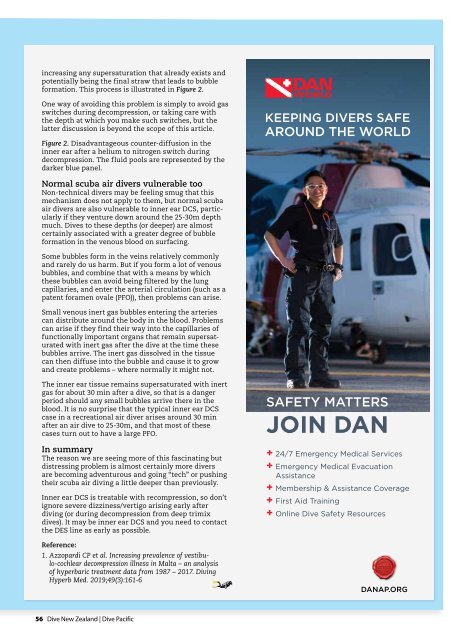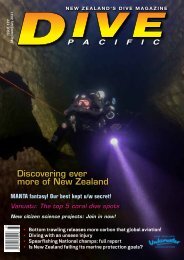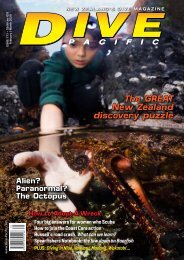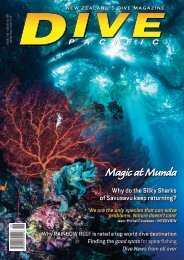Dive Pacific Iss 171 Oct- Nov 2019
New Zealand's dive magazine featuring in this issue: Shooting big sharks, up close; Spearfishing at night!; Remembering a great Kiwi dive pioneer, Wade Doak; Forgotten Vanuatu wreck's claim to fame; The invasive Lionfish - in depth, plus all our expert columnists
New Zealand's dive magazine featuring in this issue: Shooting big sharks, up close; Spearfishing at night!; Remembering a great Kiwi dive pioneer, Wade Doak; Forgotten Vanuatu wreck's claim to fame; The invasive Lionfish - in depth, plus all our expert columnists
You also want an ePaper? Increase the reach of your titles
YUMPU automatically turns print PDFs into web optimized ePapers that Google loves.
increasing any supersaturation that already exists and<br />
potentially being the final straw that leads to bubble<br />
formation. This process is illustrated in Figure 2.<br />
One way of avoiding this problem is simply to avoid gas<br />
switches during decompression, or taking care with<br />
the depth at which you make such switches, but the<br />
latter discussion is beyond the scope of this article.<br />
Figure 2. Disadvantageous counter-diffusion in the<br />
inner ear after a helium to nitrogen switch during<br />
decompression. The fluid pools are represented by the<br />
darker blue panel.<br />
KEEPING DIVERS SAFE<br />
AROUND THE WORLD<br />
Normal scuba air divers vulnerable too<br />
Non-technical divers may be feeling smug that this<br />
mechanism does not apply to them, but normal scuba<br />
air divers are also vulnerable to inner ear DCS, particularly<br />
if they venture down around the 25-30m depth<br />
much. <strong>Dive</strong>s to these depths (or deeper) are almost<br />
certainly associated with a greater degree of bubble<br />
formation in the venous blood on surfacing.<br />
Some bubbles form in the veins relatively commonly<br />
and rarely do us harm. But if you form a lot of venous<br />
bubbles, and combine that with a means by which<br />
these bubbles can avoid being filtered by the lung<br />
capillaries, and enter the arterial circulation (such as a<br />
patent foramen ovale (PFO)), then problems can arise.<br />
Small venous inert gas bubbles entering the arteries<br />
can distribute around the body in the blood. Problems<br />
can arise if they find their way into the capillaries of<br />
functionally important organs that remain supersaturated<br />
with inert gas after the dive at the time these<br />
bubbles arrive. The inert gas dissolved in the tissue<br />
can then diffuse into the bubble and cause it to grow<br />
and create problems – where normally it might not.<br />
The inner ear tissue remains supersaturated with inert<br />
gas for about 30 min after a dive, so that is a danger<br />
period should any small bubbles arrive there in the<br />
blood. It is no surprise that the typical inner ear DCS<br />
case in a recreational air diver arises around 30 min<br />
after an air dive to 25-30m, and that most of these<br />
cases turn out to have a large PFO.<br />
In summary<br />
The reason we are seeing more of this fascinating but<br />
distressing problem is almost certainly more divers<br />
are becoming adventurous and going “tech” or pushing<br />
their scuba air diving a little deeper than previously.<br />
Inner ear DCS is treatable with recompression, so don’t<br />
ignore severe dizziness/vertigo arising early after<br />
diving (or during decompression from deep trimix<br />
dives). It may be inner ear DCS and you need to contact<br />
the DES line as early as possible.<br />
Reference:<br />
1. Azzopardi CP et al. Increasing prevalence of vestibulo-cochlear<br />
decompression illness in Malta – an analysis<br />
of hyperbaric treatment data from 1987 – 2017. Diving<br />
Hyperb Med. <strong>2019</strong>;49(3):161-6<br />
SAFETY MATTERS<br />
JOIN DAN<br />
+ 24/7 Emergency Medical Services<br />
+ Emergency Medical Evacuation<br />
Assistance<br />
+ Membership & Assistance Coverage<br />
+ First Aid Training<br />
+ Online <strong>Dive</strong> Safety Resources<br />
DANAP.ORG<br />
56 <strong>Dive</strong> New Zealand | <strong>Dive</strong> <strong>Pacific</strong>













